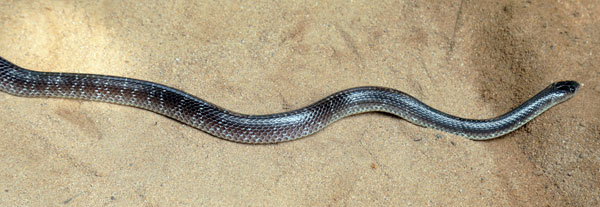News
Give a wide berth to the deadly six
View(s):By Kasun Warakapitiya
The National Zoological Gardens is advising people to study the behaviour of snakes and maintain a distance if they encounter snakes.
Veterinary surgeons, curators and reptile handlers advise people not to corner snakes.
They said snake encounters increase during extreme weather such as extreme heat and cold as the ectothermic reptiles which are incapable of self-regulation of body heat look for shaded and insulated areas to survive.

Hump nosed pit viper. Pix by M.A. Pushpa Kumara
Snake encounters increase during their breeding season as the animals’ activity level, food and water intake increases as the females prepare to increase their nutrition requirements by venturing into houses, barns, sheds, attics and even cultivated fields where their prey rodents are abundant.
The veterinary surgeon in charge of the reptilium at the Dehiwala zoo, Dr Dinuka Sonnadara told the Sunday Times that though there are 108 snake species in Sri Lanka there are only six species that can kill — Indian Cobra (Naja Naja), Russels viper (Daboia russelii), common krait (Bungarus caeruleus), Ceylon krait (Bungarus ceylonicus ), hump nose pit viper (Hypnale hypnale), and lowlands hump nosed viper (Hypnale Zara)
Dr Sonnadara said that of the six snake species which cause deaths the common krait, and the Ceylon krait has the highest potency, The cobra has neurotoxic venom which affects the central nervous system and the brain.
Russell’s viper bites are common. Its venom has a cocktail of toxins including haemotoxins, neurotoxins and cytotoxin. While the hump nosed pit viper venom includes nephrotoxins which cause renal failure and cytotoxins which cause muscle damage.

Dr Dinuka Sonnadara
The assistant curator in charge of both the reptilium and aquarium, Nalinda Jayalath suggests observing snakes from a distance rather than trying to chase them away.
Snakes should only be handled by trained people and even they take risks.
Mr Jayalath said that the Rusell’s viper and the cobra are the easiest to identify.
The Rusell’s viper has a triangular head, slit pupils and a unique pattern of spots on its body. Apart from that the viper is bulkier and has a tapered short tail from its cloaca. The cobra has a hood and false eye spots behind its hood.
The assistant curator said the behavior of two reptiles differ as cobras tend to hiss, hood up and give dry bites as a warning while the viper could strike from every direction and use its movable fangs to deliver a dose of venom.
Pit vipers too have triangular heads and heat sensing pits in their faces and are smaller..
Mr Jayalath said the krait has dark colours and bands, and scale patterns distinct to them, yet identifying them is difficult as there are non-venomous snakes mimicking them.

Nalinda Jayalath
Research officer at the National Poison Information Center at the Colombo National Hospital Anusha Dammi Weerasuriya said those bitten need to keep calm and go immediately to a hospital. Anti-venom is available and lives can be saved.
Ms Weerasuriya said others should not try to capture or kill the snake as it might lead to a second biting incident.

Indian Cobra
“If there is a mobile phone available snap a picture, if not, there are ways at the hospital to confirm whether the patient is bitten by a venomous snake.’’
In every patient, the blood is checked for clotting along with symptoms of a bite. Neurotoxic venom causes drowsiness (ptosis), blurred vision and motor skill impairment, while haemotoxic venom causes bleeding as blood cells burst.
The hump nose pit viper venom includes nephrotoxins which cause renal failure and no anti-venom exists, she said.
She said specific anti-venom is not imported due to cost and only one general anti venom is used for all snake bites. Producing locally is even more expensive, although the knowledge and expertise are available.

Common krait

Ceylon Krait

The best way to say that you found the home of your dreams is by finding it on Hitad.lk. We have listings for apartments for sale or rent in Sri Lanka, no matter what locale you're looking for! Whether you live in Colombo, Galle, Kandy, Matara, Jaffna and more - we've got them all!

